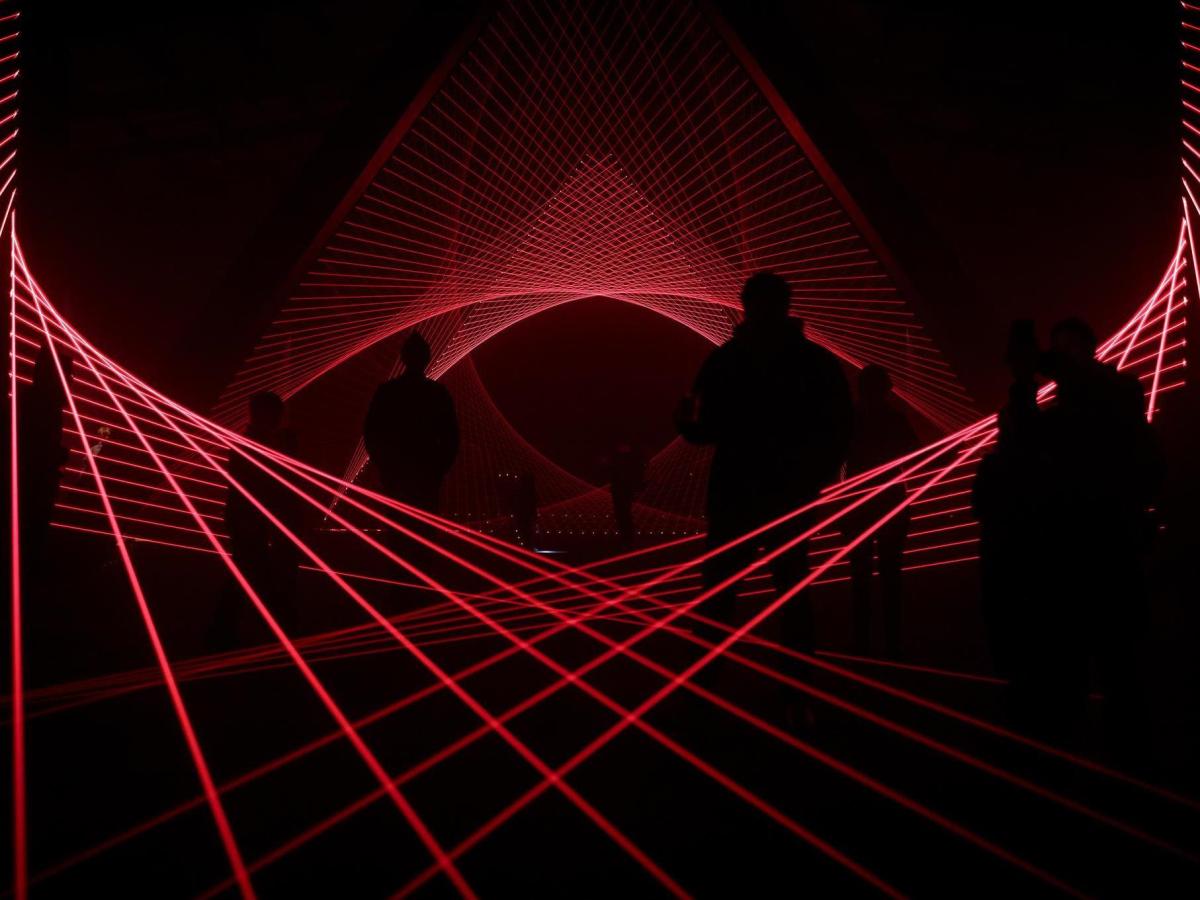Matthew Schreiber’s Leviathan at Dark Park. Photo Credit: Dark Mofo/Rémi Chauvin. Image Courtesy Dark Mofo.
Crimson lights wash across convict-quarried sandstone, and red banners flap in the chill night air. If you want evidence of the extent to which Hobart has embraced the winter festival Dark Mofo, you don’t have to look hard to find it.
From the glowing, inverted crosses whose reflections dance in the inky dockside waters to the illuminated bridge which spans the Derwent River; and from the cenotaph in Queen’s Domain to hotels in the city and individual houses along the highway leading to the Huon Valley, Hobart is awash with red lights, echoing and repeating the branding of Dark Mofo and stamping its mark across the city.
Visiting the festival is an exercise in immersion: plunging head first into the culture of the city, the crowds of interstate tourists and the chilly weather, experiencing the state’s food and wine at the hugely popular and skilfully curated Winter Feast, and – for some – diving into the dark waters of the Derwent.
Read: The allure of art in the dark: why we love winter festivals
No one visit can do justice to the festival in its entirety unless they stay for the duration of the event; nonetheless, here are some critical reflections on Dark Mofo, from the perspective of an interstate visitor who stayed for three nights with Hobart locals.
Retribution: Tanya Tagaq
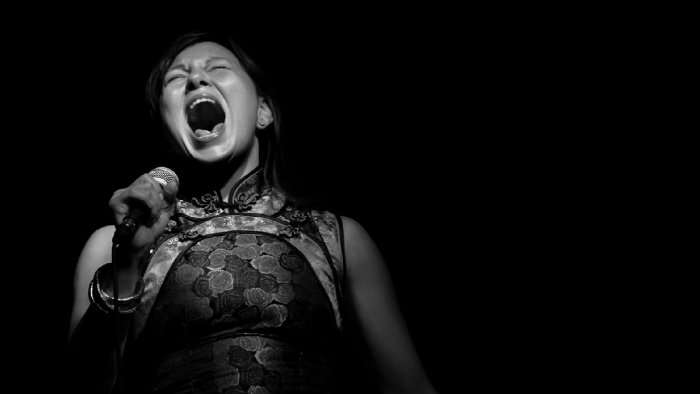
Describing what we were about to witness as an ‘improvised, fucked-up gig,’ Inuk throat singer Tanya Tagaq went on to describe the art of musical improvisation as akin to throwing a paper aeroplane: ‘You don’t know where it will end up.’
Performing alongside a percussionist and a violinist and backed by a local choir who’d had just one day to rehearse, Tagaq went on to unleash a startling sonic assault: childlike gasps, otherworldly shrieks, apocalyptic phrases and guttural groans.
Mixed with the feverish scratching and wailing of the violin, querulous drumming and the choir’s hallucinatory, semi-liturgical contribution – sometimes evoking wind or rain, at other moments echoing and emphasising Tagaq’s shrieks – the result was passionate, challenging, but never entirely transporting.
For this writer at least, Tagaq’s Retribution was a gig one observed rather than being caught up in; it never quite reached the pinnacle of intensity it seemed to be aiming for, but judging from the crowd’s enthusiastic response at the end of the evening, others were more enrapt than I.
Dark Park

United Visual Artists’ Musical Universalis. Photo Credit: Dark Mofo/Rémi Chauvin. Image Courtesy Dark Mofo.
Located in the former rail yards of Macquarie Point, Dark Park features an impressive blend of art installations, live performance, open fires, bars and free-ranging crowds.
Matthew Schreiber’s Leviathan is a dazzling highlight; a massive light sculpture that on first glance appears to be constructed of illuminated ruby filaments, but which on closer look is woven from lasers though which people walk at random, delighting in the play of light on their bodies. The temporary, flickering disruptions created by their passage through the work contrasts powerfully with the piece’s illusionary solidity, encouraging us to reflect on the permeability and flexibility of other structures in our lives.
The music of the spheres is powerfully embodied in United Visual Artists’ Musical Universalis, featuring a series of planet-like globes around which lights and speakers slowly spin. We watch these miniature moons wax and wane, accompanied by oscillating, droning sound, increasing in intensity throughout the work’s compelling cycle. It was heartening to see people watch the work for extended periods rather than dipping in and out for a quick fix; testament to the compelling nature of the installation in this age of short attention spans and Instagram.
A giant cave spider – this year’s ogoh-ogoh, which will be ceremonially burnt at the end of the festival, together with the collected fears of the many people who have visited it – and a charming performance by Terrapin Puppet Theatre of The Spider and the Fly, ideal for families, are among Dark Park’s additional attractions.
Chalkroom: Laurie Anderson and Hsin-Chien Huang
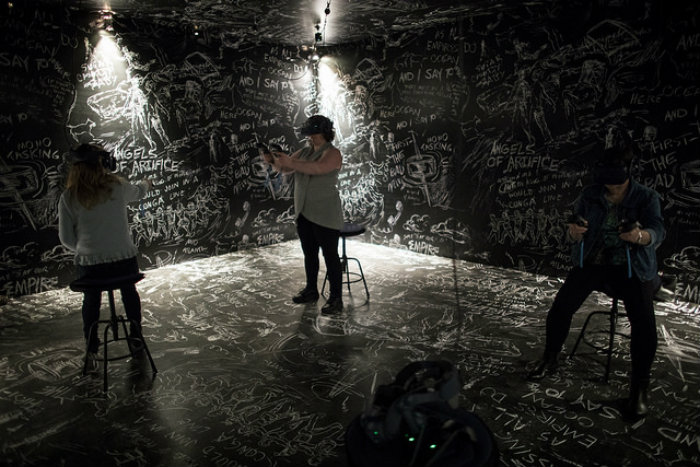
Photo Credit: Dark Mofo/Rémi Chauvin. Image Courtesy Dark Mofo.
Built in 1848-49, the neo-gothic Domain House was formerly the first high school of convict-era Hobart Town. Today the building stands largely empty, its plastered ceilings stripped back to wooden lathes and its rooms unfurnished. It’s a fascinating site, a semi-blank canvas on which to overlay the virtual reality installation Chalkroom, created by US multi-disciplinary artist Laurie Anderson and Taiwan-based new media artist Hsin-Chien Huang.
In a room whose blackened walls have been chalked to echo the virtual world we’re about to enter, we place VR headsets on and are plunged into a strange, floating city through which we can walk – and more excitingly, fly.
Its rooms are chalked with pictograms and words; walkways high above the floor lead to chambers where we can pluck chalked words from the walls and send them spinning in the air; vertigo strikes as you pause at the edge of a vertiginous drop before leaping into the air and flying through space. Despite knowing the world around you is artificial, it feels wonderfully real but simultaneously imagined – like plunging into the pages of a book and experiencing the author’s ideas springing to life around you.
Anderson’s poetic monologues are triggered by encountering glowing white cubes in this virtual space and committed travellers might perhaps find a narrative of sorts as they explore the Chalkroom in detail, should they seek to. For myself, I decided to explore its limits – flying to the city’s heights and perching on rooftops in the clouds before plunging into the depths and viewing the city from below: a collection of cubes and shapes hanging in the sky ‘in much the same way that bricks don’t,’ to quote the late Douglas Adams.
Our visit to Chalkroom is a brief but tantalising 20 minutes or so. Afterwards, take the time to climb the stairs of Domain House and experience Drones, a sound installation by the late Lou Reed (Anderson’s partner). Featuring six of Reed’s electric guitars propped against speakers – a symphony of feedback through foldback – the installation inhabits the building and is beautifully juxtaposed with Anderson’s own work, as if the two artists’ conversations were still continuing despite being separated by death.
Blixa Bargeld and St Vincent
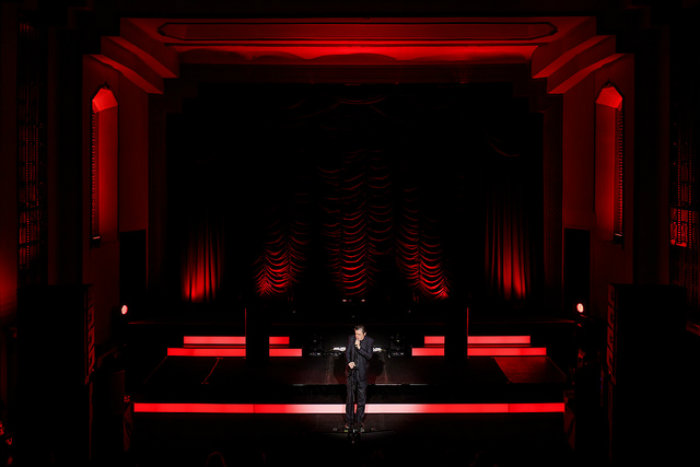
Blixa Bargeld at the Avalon Theatre. Photo Credit: Dark Mofo/Jesse Hunniford. Image Courtesy Dark Mofo.
Tasmania ‘has become hip,’ German musician Blix Bargeld observed wryly, ‘like West Berlin. Better be careful or Iggy Pop will move in.’
Performing solo at Hobart’s newly-restored Art Deco Avalon Theatre, Bargeld took to the stage prior to two subsequent gigs with his band, Einstürzende Neubauten, armed with only his voice, his sardonic presence, and a handful of effects pedals. The result, while perhaps more satisfying for hardcore followers than general audiences, was an intriguing example of playing with voice and sound. Words, phrases, shrieks and snatches of song were looped and echoed, overlaid and played back to create a sonorous tapestry of sound which appeared to delight Bargeld’s fans.
Sadly, I had to leave part-way through the performance in order to walk the 20-odd minutes from the Avalon to the Mac2 exhibition centre on the waterfront to catch US singer-songwriter St Vincent (aka Annie Clark) who was advertised as starting at 8pm. You can imagine my frustration when she didn’t come on stage until an hour later, following the screening of a 20-minute film detailing a day from hell for a woman who was supposed to be celebrating her daughter’s birthday.

St Vincent performs at Dark Mofo. Photo Credit: Dark Mofo/Rémi Chauvin. Image Courtesy Dark Mofo.
When she did finally take to the stage, Clark seemed initially hesitant and disengaged, resulting in older tracks such as ‘Now, Now’ and ‘Strangers’ feeling oddly lifeless despite crystal-clear mixing. Indeed, she didn’t totally warm up until the second half of her set (when she began to feature her latest album Masseduction, with tracks such as ‘Hang on Me’, ‘Pills’ and ‘Los Ageless’) which may not have mattered with the support of a full band – but playing solo, there was a reticence to the performance which detracted despite Clark’s powerful vocals and accomplished guitar playing.
Consequently, when a text from a friend invited me back to Dark Park, I had few qualms about departing while St Vincent was still playing. What are festivals for, after all, but for dipping in and out of experiences as the mood takes you?
Waterborne

Photo Credit: Dark Mofo/Jesse Hunniford. Image Courtesy Dark Mofo.
The existence or non-existence of the human soul will keep theologians arguing until the end of time, but what happens to our bodies after death – specifically, what happens to a dead body when it is submerged in water – is explored in exacting, occasionally confronting detail in this bleakly poetic and powerful work by British duo French and Mottershead (Rebecca French and Andrew Mottershead).
At dusk (other times are available), we board a boat and are carried upstream on the Derwent River, a short distance past the Tasman Bridge which is lit in ruddy celebration of Dark Mofo. Shortly, the boat’s engines are killed and we begin to drift downstream. Simultaneously, we don headphones and listen to a gentle monologue describing the ultimate fate of our mortal remains should our bodies ever be washed downriver and into the open sea.
Encouraged to stand at the boat’s edge, staring down at the cold waters on which we rock in order to give the sound piece extra impact, we listen to a story of decay: of pores relaxing and opening to allow microscopic organisms entry to our bodies, of skin wrinkling and sloughing away, of the bacteria in our guts devouring all available food before devouring our guts themselves.
Morbid but magical, and rigorously researched, Waterborne is an affecting and humbling art work. Its evocation of bloating bodies and the circular bites of elvers will doubtless disquiet some participants, but there’s also a quiet beauty in being reminded that the water contained in the cells of our drowned bodies will one day fall again as rain. Humans like to pretend we rule the world; Waterborne reminds us we are very much a part of it.
Lament: Einstürzende Neubauten
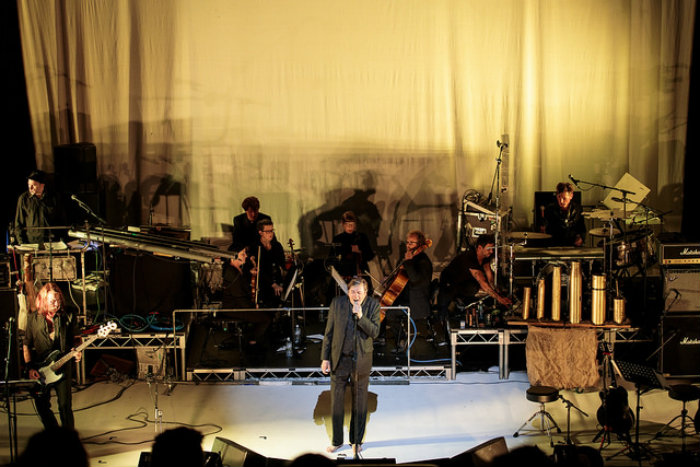
Photo Credit: Dark Mofo/Rémi Chauvin. Image Courtesy Dark Mofo.
Released in 2014, Lament is the 11th studio album from German industrial band Einstürzende Neubauten and was originally commissioned as a musical tribute to the outbreak of the First World War. This live performance of the album saw the band play Lament in its entirety, including Pete Seger’s ‘Where Have All the Flowers Gone?’ as performed by Marlene Dietrich, and early jazz tracks composed by members of The Harlem Hellfighters, a segregated black division of the US infantry.
Featuring thunderous percussion, including heavy chains dropped into metal tanks and empty artillery shells played like gongs, the concert showcased the band’s commitment to improvised instruments – including a pair of crutches that were played as both percussion and string instruments. The addition of a string quartet, featuring a number of local musicians, added depth and pathos to Neubauten’s already intense sound.
Lyrics which switched between English and German highlighted the fundamental similarities between the waring empires, while the human cost of the war was evoked through the amplified tremble of shaking, shell-shocked limbs and an extended percussive sequence played on plastic pipes, in which each pipe represented the powers participating in the war. Each pipe was struck 120 times per minute, in 4/4, with every bar of the track representing one day in the First World War. Initially exhilarating, the cumulative effect of this track as the percussion intensified, was poignant and deeply moving.
The encore included Neubauten’s ‘Let’s Do It A Dada’, complete with N. U. Unruh’s performance of a Dadaist sound poem while dressed as Hugo Ball circa the Cabaret Voltaire 1916.
Lament was more than just a concert; it was theatre – and an absolute highlight of this year’s Dark Mofo.
Dark Mofo
8-24 June 2018
darkmofo.net.au
